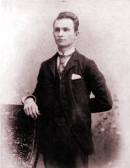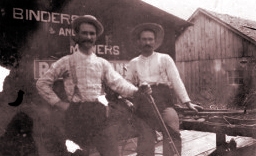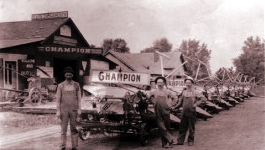
(1870-1965)
|
Baldridge Ancestral Line:
< A1 James Baldridge |
B4 Samuel Baldridge |
C6 Elizabeth Baldridge |
D1 John Turner Parish
|

|
|
|
Walter Stuart Parish
(1870-1965) |
|
A History of the Parish Family
Beginning with Thomas Parish of Nayland, Suffolk, England
(1612-1688)
By H1 Ruth Ann Parish, M.D. Walter Stuart Parish was born 10 September, 1870 to John Turner and Sarah C. Parish, the oldest boy. He attended grade school and high school in Fincastle, Ohio, and learned the trade of farming from his father. I have no details about his life to say exactly WHEN he decided to move to Cisco, Illinois, but it was clearly HIS move-his parents resided in the Fincastle area all their lives. (The 1890 Census might be helpful here, as I sense that Walter S. probably moved out "on his own" about 1890, but the U.S. Federal Census of 1890 was almost completely destroyed in a Washington D.C. fire in the early 1900s). He helped out in a store in Cisco, for awhile-perhaps that is where he learned the trade of retail business. It is certain that he grew up knowing his grandparents, and with William's bent towards business ventures, he may have learned much about business from his grandfather. We do know with certainty that he attended the 1893 Chicago Columbian Exposition, a world's fair whose history is chronicled in The Devil in the White City: Murder, Magic and Madness at the Fair that Changed America, by Erik Larson (copyright 2003). This World's Fair was specifically designed to show to the world the technological wonders of which America was capable, (and to compete with the 1889 World's Fair of Paris, France, from which we got the Eiffel Tower)-from the Agriculture Building, which encompassed 64 acres under a single roof, to the 234 foot radius Ferris Wheel on the midway (see enclosed CD-ROM for photos of this fair). It was certainly able to fire the imagination of a 23 year old young man regarding the possibilities for the future in "the West". Walter held his dream in check long enough to marry Nora Belle McCartney (born 4 December, 1876 in Jewell County, Kansas)-she was a "Centennial Girl", being born 100 years after the Declaration of Independence, and Walter often referred to her this way. Her parents were Thomas McCartney and Cynthia Madden. Walter and Nora married 4 May, 1898 at her parents' home.Walter and a group of 14 other men (including his brothers Will, Fred, and 'Carm') had heard about the well-publicized land lottery in Idaho, to be held in October, 1904. They chartered a Pullman railroad car to Shoshone, and went south from there by overland stagecoach, crossing the Snake River by ferry and staying at the hotel run by the Walgamots of Shoshone Falls. The looked over the tract near the Twin Falls, and gave their power of attorney and their preferences in land to a Mr. Costello, because the lottery was more than a month away. They did visit the Blue Lakes Ranch home of I.B. Perrine, where they had a lovely dinner-Mr. Perrine looked favorably upon energetic young (white) men to move into the territory. All but one of the men drew land in the lottery, and thanks to Mr. Costello's honesty, it was GOOD land, extending from the Snake Canyon south to Pole Line Road, and from Rock Creek on the east, to Cedar Draw on the west. This tract soon became known as "Sucker Flat" (because the majority of folks who settled there were from Illinois, the 'Sucker' State, rather than because they were easily duped). The story goes that Mr. Costello, trying to lay out the tracts for his eastern buyers, tied a rag around the spokes of his wagon and counted the rotations in order to ascertain distances, since there was nothing but endless sagebrush in that area. The family arrived in Twin Falls 3 November, 1905, after a trip of 3 days and 4 nights-however, the branch-line of the railroad had been built by that time, so the entire trip was made by train. John T. Parish Sr. remembered how loose was the topsoil as they walked up Shoshone street, full of large potholes. The family first lived in a small house at 252 Second Avenue North, where Walter pitched a tent to shelter his horses. They hauled water to the house from a hydrant across the street. The family lived there for a month before Walter built a "prove-up" shack on his parcel of land. By the spring of 1906, their house was ready. Life was indeed hard-they subsisted on rabbit, which they could shoot, and vegetables from their own garden. That first winter, John remembered that the first order of business each day was to sweep snow off the roof of the prove-up shack. The wheel tracks from the Oregon Trail crossed Walter's land at the southwest corner of that first farm, just south of the Snake River Canyon. Those ruts were so deep that, as a small boy sitting on a wagon box, John could barely see over the sagebrush. (The pioneers quickly realized that the way to tell the really good soil was by the height of the sagebrush growing there. In many places, a horse grazing with its head down could be completely hidden by sagebrush). The brothers Will, Fred and Carm all lived with Walter's family for the first year. John Sr.'s job, as a young boy, was to gather sagebrush and cut it up-the stalks were used in the cookstove, and the larger pieces for the heating stove. Soon the Parish men had piles of sagebrush as large as haystacks, which they grubbed by dragging a railroad tie over the land with horses several times. What didn't come out that way, they had to pull out by hand, raking it into wind-rows with large rakes called "dump rakes". But the sagebrush supply far exceeded what was needed for livelihood, so the excess was burned in the evenings, giving rise to the oft-told early day descriptions of the evening horizon bright with many sagebrush fires. Once the land was cleared, the hard work had paid off-the first crop of wheat was 56 ½ bushels to the acre, compared to 8 or 9 bushels per acre in Illinois. Walter and his brothers also began a successful hardware business in Twin Falls, selling supplies to the pioneer farmers. Walter and Nora had three children: John Thomas Parish (Sr.), born 18 May, 1899; Hazel Mae Parish (Bucklin Stearns), born 26 June, 1906, died 9 June, 2000; and Dorothy Lucille, born 19 November, 1912 (she died at the age of 7, when she tripped and fell into a washtub of scalding water). Hazel Mae married Thomas Bucklin (born 5 April, 1900, died 1969) with whom she had two children: Thomas Jr. (born 15 February, 1930, married Shirley _____, they had Ted, David and Darci) and Beverly (born 4 July, 1940, she married (ret.) Air Force Colonel Thomas Pickering, and they had Scott and Kathy). Hazel later married Bill Stearns, her high school sweetheart, and they had a merry time together until his death in 1997. Walter was interviewed once on tape by his grandson-in-law, Thomas Pickering (Beverly's husband) for a college project on the pioneer movement. When asked whether he would do the pioneer life again, he replied-"No! Too much work!" (However, he DID retire at the age of 49!) Nora died 10 March, 1954; Walter died 14 July, 1965, both in Twin Falls, Idaho, where they are interred. One good fishing story about Walter-and I can attest to its truth, because it happened while we were visiting my grandparents (John Sr. and Ruth): he loved to go fishing in the reservoir at Salmon Dam, on the Snake River (as well as a trip each summer to Stanley, Idaho, on the middle fork of the Salmon River). One day he took out a new rod and reel, hooked a big salmon, and the fish tore the pole and rig right out of his hands, dragging it into the reservoir. He calmly went back to his car, got out ANOTHER rod and reel, cast into the same place, got the fish AND retrieved the rod and reel! Walter also loved to play cards, especially pinochle, where he would pound his fist on the arm of his chair and whistle tunelessly as he played-he was a man with a great sense of humor, and loved his family dearly. Nora's younger sister, Pearl E. McCartney (born 29 June, 1879, died ?), married Walter's younger brother, William Warren (born 17 October, 1873) on 28 February, 1900, and they had the following children: Velma Parish (born 1 May, 1901, married William Baker-they had a daughter Barbara); Wilma (born 19 November, 1902, married Harry Wilson-they had a son Ronald); Wayne Parish (born 31 May, 1906, married Mae Franklin); Helen Parish (born 6 January, 1910, married Charles Stevens later in her life-she was an R.N. who taught nursing at Stanford University Hospital-no children); and Evelyn (born 23 July, 1917, married Albert Horton).

Walter (left) and Will Parish
In front of their store in Twin Falls, Idaho
ca. 1910
Walter and Will Parish
ca. 1910
|
The Baldridge Family History is a project of Carol M. Gillespie, D.D.S. You can contact Carol at: CGillespi2@aol.com. Please enter a Subject of Baldridge Genealogy, to help us separate your message from spam. The HTML version was created by Eric Davis. |